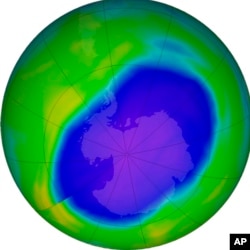The hole in the ozone layer over Antarctica last week reached its largest size since 2015. It is the third straight year the hole has reached more than 24.8 million square kilometers. That is a bit larger than the size of North America.
But experts say that, in general, the hole is getting smaller year by year.
“The overall trend is improvement. It’s a little worse this year because it was a little colder this year,” said NASA Goddard Space Flight Center Chief Earth Scientist Paul Newman.
Cooler-than-normal temperatures high in the atmosphere over the southern polar areas increased clouds. And the clouds release chlorine and bromine chemicals, Newman said. These chemicals react with the ozone and break it apart.
Some experts say the cooler air above Antarctica is the result of climate change. Even though heat-trapping carbon from coal, natural gas and oil make Earth’s surface warmer, the upper atmosphere gets cooler. But Newman said the ozone area above Antarctica might be too low to be cooled by climate change.
Some scientists worry that climate change will start affecting efforts to reduce the ozone hole. “The fact that the stratosphere is showing signs of cooling due to climate change is a concern,” said Martyn Chipperfield. He is an atmospheric scientist at Britain’s University of Leeds.
In 1987, the world agreed to an important treaty called the Montreal Protocol. The treaty banned ozone-destroying chemicals. It took many years to see the effects of the treaty. That is because some of the chemicals that destroy ozone, such as CFC11, can stay in the atmosphere for decades.
Chlorine levels are down almost 30 percent compared to their highest level 20 years ago, Newman said.
University of Colorado’s Brian Toon noted that large fires in Australia and the addition of huge amounts of water from January’s undersea volcanic burst are new factors that may be affecting the ozone hole.
I’m Dan Friedell.
Seth Borenstein wrote this article for the Associated Press. Andrew Smith adapted it for VOA Learning English.
______________________________________________________________________
Words in This Story
trend -n. a developing pattern over time
polar -adj. relating to the far northern or far southern regions of the earth and extreme cold
protocol -n. rules or standard customs for the way of doing something
decade -n. a period of ten years
______________________________________________________________________
We want to hear from you.
We have a new comment system. Here is how it works:
- Write your comment in the box.
- Under the box, you can see four images for social media accounts. They are for Disqus, Facebook, Twitter and Google.
- Click on one image and a box appears. Enter the login for your social media account. Or you may create one on the Disqus system. It is the blue circle with “D” on it. It is free.
Each time you return to comment on the Learning English site, you can use your account and see your comments and replies to them. Our comment policy is here.









Forum